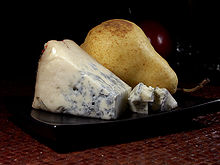- Gorgonzola (cheese)
-
Gorgonzola 

Country of origin Italy Region, town Gorgonzola Source of milk Cow, Goat Pasteurised Yes Texture Soft and crumbly Fat content 25-35% Aging time 3–4 months Certification Italy: DOC from 1955;
EU: PDO from 1996[1]Gorgonzola (Italian pronunciation: [ɡorɡonˈdzɔːla]) is a veined Italian blue cheese, made from unskimmed cow's and/or goat's milk. It can be buttery or firm, crumbly and quite salty, with a "bite" from its blue veining.
Contents
History
Gorgonzola has reportedly been produced in the town of the same name since AD 879,[2] acquiring its greenish-blue marbling in the eleventh century. However, the town's claim of geographical origin is disputed by other localities.[3]
Production
Today, it is mainly produced in the northern Italian regions of Piedmont and Lombardy. Whole cow's milk is used, to which starter bacteria is added, along with spores of the mould Penicillium glaucum; Penicillium roqueforti, used in Roquefort cheese, may also be used. The whey is then removed during curdling, and the result aged at low temperatures.
During the aging process metal rods are quickly inserted and removed, creating air channels that allow the mould spores to grow into hyphae and cause the cheese's characteristic veining. Gorgonzola is typically aged for three to four months. The length of the aging process determines the consistency of the cheese, which gets firmer as it ripens.
Under Italian law, Gorgonzola enjoys Protected Geographical Status. Termed DOC in Italy, this means that it can only be produced in the provinces of Novara, Bergamo, Brescia, Como, Cremona, Cuneo, Lecco, Lodi, Milan, Pavia, Varese, Verbano-Cusio-Ossola and Vercelli, as well as a number of comuni in the area of Casale Monferrato (province of Alessandria).
Gorgonzola made with goat's milk is firm and salty. It is made usually in the Prealpi area of Piedmont and Lombardy, especially in the provinces of Lecco and Alessandria.
Consumption
Gorgonzola may be eaten in many ways. It may be melted into a risotto in the final stage of cooking, or served alongside polenta. Pasta with gorgonzola is a dish appreciated almost everywhere in Italy by gorgonzola lovers; usually gorgonzola goes on short pasta, such as penne, rigatoni, mezze maniche, or sedani, not with spaghetti or linguine. Because of its distinctive flavor, it is frequently offered as pizza topping. Combined with other soft cheeses it is an ingredient of pizza ai quattro formaggi (four-cheeses pizza).
Notes
External links
Italian cheeses PDO - Asiago
- Bitto
- Bra
- Caciocavallo Silano
- Casciotta d'Urbino
- Castelmagno
- Pecorino sardo
- Fontina
- Gorgonzola
- Grana Padano
- Montasio
- Monte Veronese
- Mozzarella di Bufala Campana
- Parmigiano-Reggiano
- Pecorino
- Pecorino Romano
- Sardo
- Siciliano
- Toscano
- Piave
- Provolone
- Raschera
- Taleggio
- Toma Piemontese
- Valle d'Aosta Fromadzo
- Valtellina Casera
Non-protected
varieties- Bel Paese
- Bocconcini
- Brös
- Burrata
- Cacio figurato
- Caciotta
- Caprino
- Casu marzu
- Crucolo
- Dolcelatte
- Galbanino
- Mascarpone
- Morlacco
- Mozzarella
- Paddraccio
- Pallone di Gravina
- Ricotta
- Robiola
- Rosa Camuna
- Scamorza
- Sottocenere al tartufo
- Stracchino
- Stracciatella di Bufala
Blue cheeses - Ädelost
- Aura
- Abbey Blue Brie
- Bellingham Blue
- Bleu Bénédictin
- Bleu de Bresse
- Bleu des Causses
- Bleu d'Auvergne
- Bleu de Gex
- Bleu du Vercors-Sassenage
- Bleuchâtel
- Blue Castello
- Buxton Blue
- Cabrales cheese
- Cambozola
- Cashel Blue
- Cheshire cheese
- Crozier Blue
- Danish Blue
- Dolcelatte
- Dorset Blue Vinney
- Dovedale cheese
- Dragon's Breath Blue
- Fourme d'Ambert
- Fourme de Montbrison
- Gamalost
- Gorgonzola
- Grinzola
- Lanark Blue
- Lymeswold cheese
- Maytag Blue cheese
- Newport 1665
- Norbury Blue
- Picón Bejes-Tresviso
- Rokpol
- Roquefort
- Saint Agur Blue
- Shropshire Blue
- Stichelton
- Stilton cheese
- Valdeón cheese
- Wensleydale cheese
- Wrekin White
Categories:- Italian cheeses
- Cow's-milk cheeses
- Blue cheeses
- Italian products with protected designation of origin
- Foods named after places
Wikimedia Foundation. 2010.
